Tailings from Sumpter Valley
Gold Dredging
June 17, 2007.
We are staying at Mountain View Travel Park in Baker
City, Oregon. $24.79 FHU, shade and a nice enough RV-Park.
It must be a former KOA (Keep On Adding) since they charge extra for
everything, $2 extra for wifi, $2 extra for larger sites, you get
the picture Keep On Adding.
Tailings left by Sumpter
Valley Gold Dredges
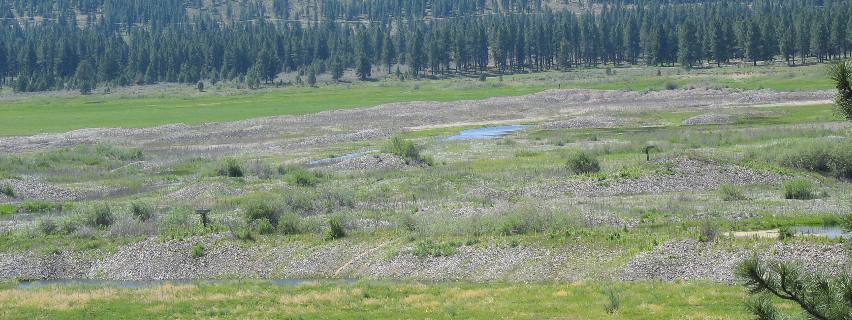
Three gold dredges operated in the Sumpter
Valley, on and off, from 1913 to 1954. Periods of dredging
activity were influenced by the fluctuating prices of gold, the Great
Depression, the Second World War, and equipment breakdowns. The dredges
dug up 2,500 acres of farmland extracting approximately $10,000,000
in gold.
Tailings left by Sumpter
Valley Gold Dredges
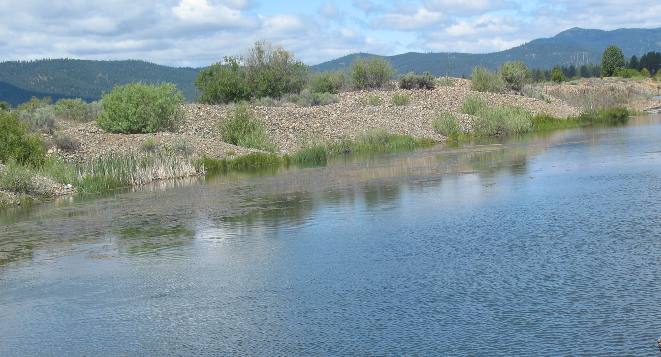
Dredging ended when profitable land for mining became scarce-----in
other words they dug up the entire valley.
These rock piles have been exposed since dredging activity ceased
in 1954.
Three dredges operated on and off in the Sumpter Valley.
The dredge on display
at Sumpter Valley State Park dug up thousands of acres of Sumpter
Valley during the 19-years it operated here. It extracted
about 9-tons of gold (about one cubic yard). At current gold prices
of say $350 an ounce that would be 9-tons of gold worth, by my calculations,
$100,800,000.
A gold dredge is basically
a giant shovel mounted on the deck of a boat. Instead of one bucket,
this dredge had 72, each weighing a ton (as much as my Saturn automobile).
The assembly of buckets was called the digging ladder.
This dredge was built
on dry land (for about $300,000) and launched like a boat into a hand-dug
pit filled with water. The digging ladder could scoop out 25 buckets
per-minute of earth, rock and minerals as the dredge chewed its way
forward, floating on the pond it created. The excavated material was
transported up the ladder and dumped into a series of screens inside
the dredge.
Massive amounts of electricity were needed to operate a dredge. Long
before any of the surrounding farms got electricity, a 12 mile, 23,000
volt line was strung to the dredge
overland from a hydroelectric power plant.
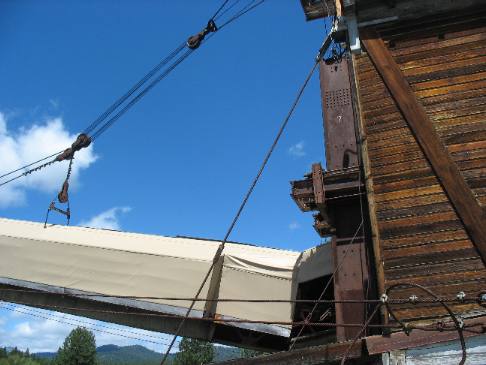
Every rock larger than 3/4 of an inch emptied out the back of the
dredge. The 96 foot "stacker" to the rear of the dredge
was like a conveyor belt, carrying out the largest rocks and creating
the "tailings piles" we see throughout the valley.
Tailings from Sumpter
Valley gold dredging operations
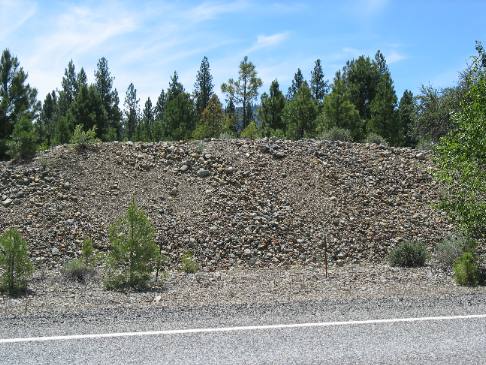
Tailing piles like this have marred Sumpter
Valley for over 50-years and will probably mar the valley
for hundreds of more years.
According to the inscription on his gravestone, Henry H. Griffin
first discovered gold in eastern Oregon.
Griffin came with other prospectors in 1861 (8-years before the transcontinental
Rail Road was completed). A few miles from Sumpter
in a place they still call Griffin Gulch, he hit pay dirt. Over 30,000
men flooded in to stake claims. The town of Sumpter
grew a short distance away.
For 20-years, miners panned and sluiced the rivers and hillsides
to bedrock. Then, a railroad built to Sumpter
Valley from Baker
City brought pneumatic drills and compressors. Mining shafts
were sunk deep into the mountains following veins of gold in quartz.
Development boomed. Mills were built, that could crush 100 tons of
ore per-day.
Volcanoes and earthquakes are evidence that the earth's crust is
constantly changing. Terribly strong and often violent, these forces
created the mountains of eastern Oregon. They are also responsible
for the mineral riches found here.
The shifting, thrusting earth created intense heat, which turned
rock to molten form, called magma. As it pressured its way to the
surface through older rock, the magma melted some minerals in the
rock, forming a watery metal-rich liquid. As the magma cooled, vein-like
cracks developed in the surrounding rocks. It was here in these cracks
that quartz and metals, including gold, crystallized. These deposits
are called "lode veins."
During the Ice Age, glaciers scoured away mountain tops exposing
the veins of gold. Further erosion and gravity brought the gold tumbling
down the mountain sides, eventually settling in creeks and washing
out into the Sumpter
Valley.
The material dredged up by the Gold
Dredge including larger rocks and gravel were carried to the
rear of the dredge and dumped into tailing piles by the stacker.
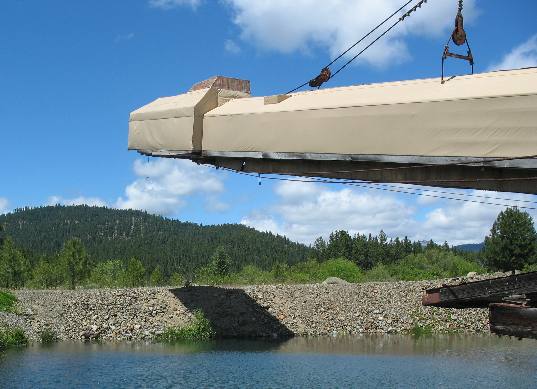
This is the "stacker" that carried larger rocks and gravel
out and staked this useless rock into tailing piles like the one in
this picture.
Mike & Joyce Hendrix

Mike
& Joyce Hendrix who we are
We hope you liked this page. If you do you might be interested in
some of our other Travel Adventures:
Mike & Joyce Hendrix's home
page
Travel Adventures
by Year ** Travel
Adventures by State ** Plants
** Marine-Boats
** Geology ** Exciting
Drives ** Cute Signs
** RV
Subjects ** Miscellaneous
Subjects
We would love to hear from you......just put "info" in
the place of "FAKE" in this address: FAKE@travellogs.us
Until next time remember how good life is.



